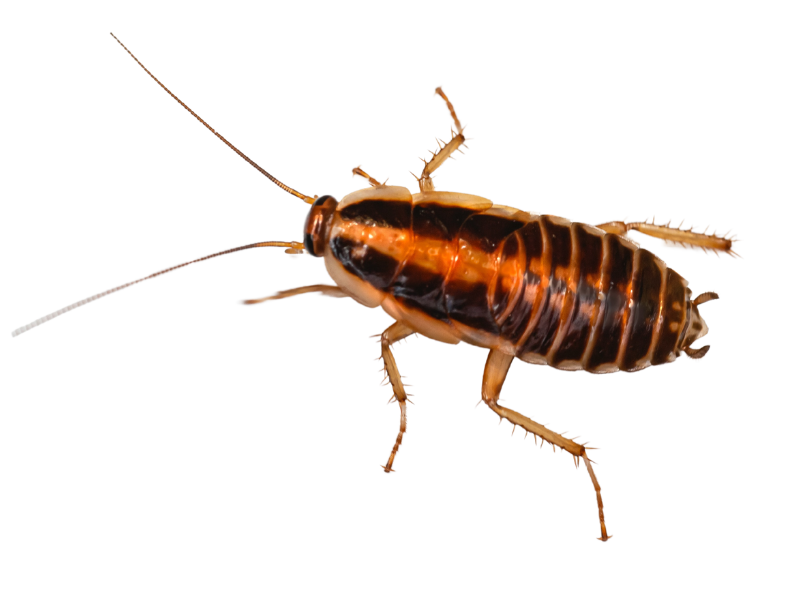Crawling Insects
-
We Can Help With
✅ Ants
✅ Fleas
✅ Cockroaches (commercial only)
✅ Bed Bugs (commercial only) -
We Can't Help With
❌ Woodlice
❌ Clothes or carpet moths
Problems with Crawling Insects
-
Worker ants are 4-5mm in length but the Queen can be as big as 15mm. Queens lay their eggs in the spring in nests that are typically in soil but can be in brickwork or under bark. Garden Ants are attracted to sweet foods and leave a pheromone trail back to their nests for other ants to follow to the food source.
The majority of black or garden ants will only come into your home to forage for food and are attracted by sweet and sticky substances. Ensure that there is no readily available food source in your home.
You can help prevent Ants entering your home by sealing access points such as cracks and crevices in door and window frames.
A note about flying ants: if the ants in your garden have grown wings and started flying, they are at the end of their life cycle. Allow 48 hours and you should notice that you no longer have a problem.
-
Fleas are a small (2mm) wingless insect, flattened side to side and reddish-brown in colour. The flea has spines that are pointed backwards and legs that enable it to jump extremely well.
Fleas are a common problem in homes especially for those with cats or dogs. They are also frequently found when moving into a home that previously had pets.
All adult fleas are parasitic on warm-blooded animals. Larval stages live in the nest of the host and feed on skin, feathers and, most importantly, the blood-rich faeces of the adult flea. When fully grown the larvae spin well camouflaged silken cocoons. When fully developed, the adult waits within this until it detects the vibrations caused by a potential host. Only then does it emerge. The complete lifecycle of the flea takes only four weeks in the summer months
The flea bite is usually felt immediately, but it does not particularly hurt. It is the itchiness that results from the body’s reaction that causes discomfort. Different people react differently to a bite, both in terms of degree of reaction and time taken to react.
Flea cocoons can remain dormant for two years or more and are awoken by the vibration of footsteps. It is very common for a flea infestation to remain dormant in an empty home but to awaken when people move in.
Infants are at higher risk from being flea bites particularly when playing on the floor. They also tend to be more sensitive than adults to being bitten by fleas.
While fleas cause humans distress, it is pets who are often much more affected by bites from fleas.
-
Adult bedbugs are 5mm long. All species of bed bug feed on warm blooded animals. Cimex lectularius is the bedbug that feeds on blood from humans, which can result in painful bites. They are usually found in bedrooms but hide in cracks and crevices during the day. Before feeding they are a flattened oval shape and light brown, but become rounder and darker after feeding. They are nocturnal and attracted to both the warmth of our bodies and the carbon dioxide in our breath. The most common shelters for bedbugs are in the seams of mattresses, in crevices in the bed frame, behind furniture surrounding the bed (especially the headboard) or where the wall meets the floor
Bedbugs are becoming an increasing problem in this country and around the world. Their resurgence may well be related to a global increase in international travel (bedbugs are known to travel in luggage or clothing), as well as a possible increase in their resistance to certain pesticides. There is also a general lack of awareness of signs that point to an infestation.
-
In this part of the country, it is very unusual to find cockroaches in domestic settings.
Cockroaches are nocturnal and hide during the day. You will most likely see them when turning on the light in the kitchen at night. They shed their skin 5-8 times as they mature.
They leave a dust of black/dark brown droppings that are cylindrical & less than 2mm wide if water is scarce. They are found on horizontal surfaces & wall-floor junctions where cockroaches run
If water is readily available, cockroaches produce smear marks instead of droppings, they are brown in colour and irregular in shape.
Established cockroach infestations produce an unpleasant, musty smell.
Cockroaches are omnivorous and will eat almost anything; food stuffs, organic goods including leather, books, paper, clothing and animal matter (such as hamster or rabbit droppings – as well as their food). They will also consume packaging, plastics etc and can therefore cause substantial damage.
Useful information for our visit
We will schedule an appointment for one of our technicians to visit you. Please let us know if there are any parking restrictions at your property.
If you have fleas we recommend vacuuming before we arrive as you will not be able to vacuum for 14 days after our visit. After this time, all eggs should have hatched and with live fleas treated by the treatment we spray on your floor coverings.
Your technician will assess the environment upon arrival. We have our own tools but, in advance of our arrival, any assistance you can provide to give us clear access to the problem area is much appreciated, particularly floor coverings if we are treating visit.
Bed bugs can live or lay eggs on any textile. In addition to our visit you will also need to take measures to treat all items on your premises with fabric, such as bed linen, towels etc.
Why don’t you deal with some crawling insects?
Woodlice are not considered a pest and we therefore don’t deal with them. They may be a little unsettling, however they do not cause damage to their environment and do not transmit diseases to humans.
Clothes and carpet moths can be tricky to deal with and we won’t offer a service if we aren’t confident of a positive outcome.
We only offer services for cockroaches in a commercial setting because they are extremely rare in a domestic environment in this part of the UK.


